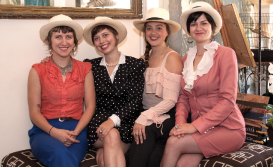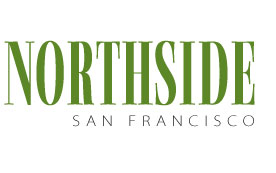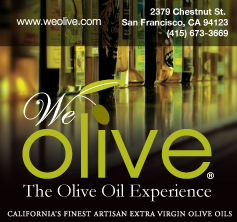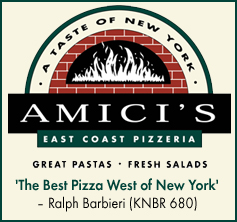
L to R: Abbe Dwelle, Olivia Griffin, Kirsten Hove,
and Wendy Hawkins photo: John F. Martin
As a Panama hat cultist who favors the Charlie Chan model known technically as the Optimo, I’ve kept a watchful eye for the past year on a small shop in the outer Richmond.
The shop, Paul’s Hat Works, a venerable Panama hat shrine, has been in San Francisco since 1918. And through all those years until recently there have only been three “Pauls” – three skilled hat-making proprietors.
The first was a Peruvian merchant seaman named Napoleon Marquez who inexplicably jumped ship here, changed his name to Paul, opened Paul’s Hat Works out on Geary Boulevard and created fine Panama hats for 37 years. Then came Napoleon’s godson Kelly Bowling who ran the shop for another 25 years. Then in 1980 Michael Harris became keeper of the Panama hat flame. Harris remained
el jefe, the chief, until March of last year when suddenly the number of Pauls jumped by four. Michael Harris retired and something new was in the wind.
And the reason this Optimo-wearing devotee paid close attention to Paul’s Hat Works is that the new Pauls are four young San Francisco roommates – Olivia Griffin, Abbie Dwelle, Wendy Hawkins, and Kirsten Hove. You might assume these four stylish upstarts would be more familiar with other fashions than those wonderful gossamer creations known as Panama hats. Well, you would be wrong, because the four young women who apprenticed under Michael Harris have become Panama hat visionaries, and are not only fashioning the elegant straw creations but felt fedoras as well.
They have also injected their high-profile personalities into the fabric of San Francisco life – Panama hat fashion shows and open house parties at the shop, for example. And recently, they created Panama hats for the City’s Boxcar Theatre, which is currently presenting three Tennessee Williams plays in repertory (see “Northside Picks” on page 9). Ideal hat casting I would say. My conclusion is the concept of the Panama hat is safe in the hands of the four new Pauls.
Star status
And now comes the transition: I suppose I set you up for this, but what follows is an unabashed tribute to the Panama hat. For many zealots – both men and women by the way – there are few uncommonly rare objects in this world that satisfy like a fine Panama hat. They weigh no more than a few ounces, and the finest of them have a value exponentially far in excess of their weight. But don’t just take my word for it. Others who have equated Panama hats with the dearest of luxury possessions include Teddy Roosevelt, Franklin D. Roosevelt, Winston Churchill, Harry Truman, Humphrey Bogart, Gary Cooper, Sydney Greenstreet, Peter Lorre, Nina Foch, Greta Garbo, Tennessee Williams, Truman Capote, Charlie Chan, Tom Wolfe, Paul Theroux, Peter Mayle, and Willie Brown Jr., just to name a few Panama hat hotshots.
These days, fine Panama hats continue to be found gracing the heads – swelled or otherwise – of statesman, politicians, actors, rock stars, business tycoons, playwrights, and writers for Northside San Francisco.
In Peter Mayle’s book Acquired Tastes, required reading for anyone aspiring to a life of luxe, Mayle says at first he was not a believer in the cult of the Panama hat: “I could have carried my ignorance to the grave if a friend – knowing of my interest in anything preposterously extravagant – hadn’t told me about a hat that cost $1,000. But not a solid, indestructible, waterproof, lifetime investment of a hat. This was a mere straw hat. Who would be lunatic enough to pay out four figures for less than three ounces which you hardly know you had on your head.”
Birth of the hat
But why are they called Panama hats when they actually originate in Ecuador? Because Ecuador was producing fine straw hats as early as 1630. In the late 1800s, they were exported and sold in Panamanian ports. Workers on the Panama Canal wore these Ecuadorian straw hats to ward off the tropical sun. A photo of 26th President Teddy Roosevelt shot in 1906 shows him wearing an Ecuadorian Panama hat while viewing the canal’s excavation.
The Ecuadorian province of Manabi historically has been the center of straw weaving, and the town of Montecristi has become famous for the skill of its weavers. It’s from Montecristi that Paul’s Hat Works acquires the woven, unfinished “bodies” from which our four hat makers fashion these masterworks.
Panama hats are woven from the carludovicia palmate, which despite its frond-like leaves comes from the family of the screw pine, not from palm trees. The fronds are gathered, sorted and dried. Then they are shredded by hand into long thin strands and then sorted again. Finally the weavers take over in the middle of the night when temperature and humidity are the most constant. The weavers are usually young women with delicate but skilled fingers, we are told. They weave almost microscopic cross hatches into tiny, flat rosettes. Over the weeks and months these rosettes become larger and larger. When a hat crown has been woven and shaped, the weaver works her way outward, along what will be the brim. But the weaver does not complete the brim and a finished “body” remains with hundreds of strands of fiber sticking out from it. Paul’s Hat Works purchases these unfinished bodies and takes it from there.
Styles galore and personalized service
There are dozens of styles of Panama hats but Paul’s Hat Works’ customers usually prefer one of four. These are the Optimo or Charlie Chan model (my favorite), the teardrop crown Planter (pointed crown and a wide curled brim), the open Telescope Planter (a round crown), and the Fedora. If Indiana Jones had worn a Panama hat instead of a felt model, the Panama Fedora is the one he would have chosen.
These days when serious customers visit Paul’s Hat Works, Griffin, Dwelle, Hawkins, and Hove handle them like a rare Stradivarius violin – carefully and with dignity. They dazzle their customers as they set an ancient hatter’s apparatus called a conformiture on their skulls. The conformiture is a wood and metal contraption that fits on the head like a loose hat, just on top of the ears. In my case, Griffin, with a firmness that belies her delicate appearance, pushes the old machine down until more than 50 flat blades fit tightly against the head – just as a real hat would. I half expected her to plug the contraption into a wall socket that would fry my brain. But it’s from this form – hence conformiture – that the Paul’s Hat Works’ team create the custom-fitted, sublime headgear. They shape and reshape these treasures over an ancient steam boiler, blocking them to perfection. The finished product goes for about $300 on up – quite a way up.
Panama hat cultists are a finicky, esoteric breed that believes in the legacy of Montecristi. They have a highly developed sense of just what should crown their skulls, and at Paul’s Hat Works the legacy continues.
Paul’s Hat Works: 6128 Geary Boulevard (between 25th & 26th), Tuesday–Sunday 10 a.m.–7 p.m., 415-221-5332, www.hatworksbypaul.com
Ernest Beyl has long been a Panama hat devotee. No, he didn’t wear one when he traveled to the Isthmus of Panama with Teddy Roosevelt.
E-mail: ernest@northsidesf.com.








